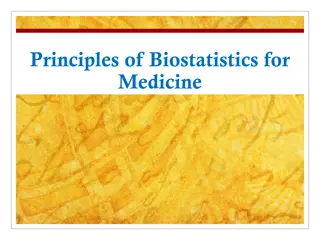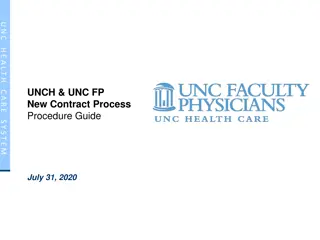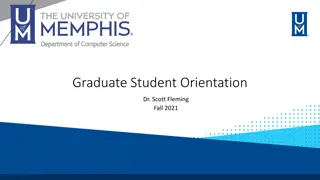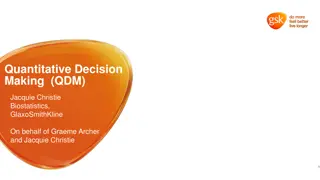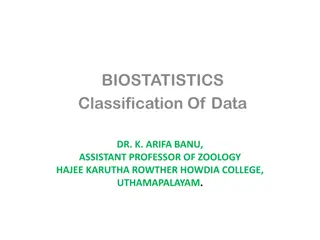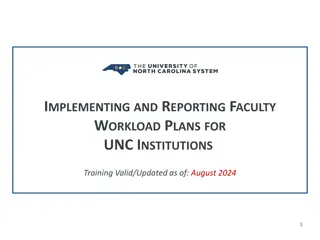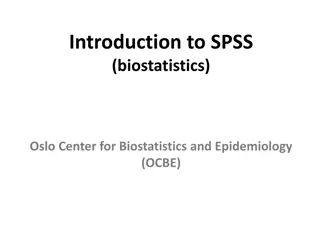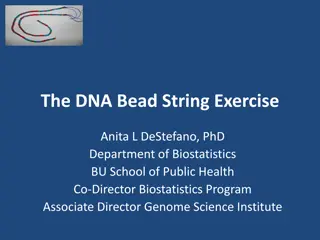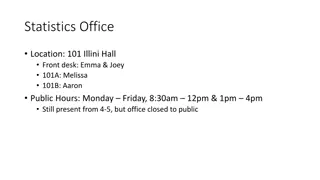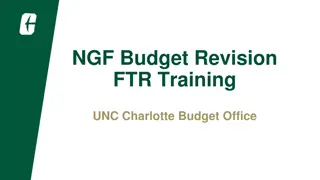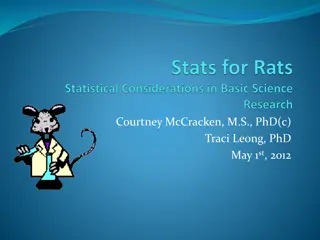Enhancing Statistics Majors for Graduate Studies: Insights from UNC-CH Biostatistics Department
Explore the initiatives undertaken by the UNC-CH Department of Biostatistics to prepare statistics majors for graduate study. Discover admission trends, curriculum highlights, and factors that make statistics majors successful applicants in the field of biostatistics.
Download Presentation

Please find below an Image/Link to download the presentation.
The content on the website is provided AS IS for your information and personal use only. It may not be sold, licensed, or shared on other websites without obtaining consent from the author.If you encounter any issues during the download, it is possible that the publisher has removed the file from their server.
You are allowed to download the files provided on this website for personal or commercial use, subject to the condition that they are used lawfully. All files are the property of their respective owners.
The content on the website is provided AS IS for your information and personal use only. It may not be sold, licensed, or shared on other websites without obtaining consent from the author.
E N D
Presentation Transcript
Preparing Statistics Majors for Graduate Study (Perhaps Your Own!) ASA Working Group to Revise the Undergraduate Statistics Curriculum Winter 2013
Outline Introduction of Invited Participants Sandy Weisberg, Univ of Minnesota Jane Monaco, UNC Biostatistics Simon Sheather, Texas A&M Mark Ward, Purdue Questions for Panel Open Discussion
UNC-CH Dept Biostatistics Admissions by Major (2013) Masters Degrees: MPH/MS Our BSPH Bios Majors Other Stat Majors Math Majors Other Majors TOTAL # Applied # Accepted (% Accepted) 1 (50%) 7 (20%) 9 (43%) 19 (19%) 36 (23%) # Matriculated 2 0 3 5 35 21 100 158 10 18 Doctoral Degrees: DrPH/PhD Our BSPH Bios Majors Other Stat Majors Math Majors Other Majors TOTAL # Applied # Accepted (% Accepted) 3 (100%) 9 (16%) 26 (45%) 3 (5%) 41 (23%) # Matriculated 3 1 4 56 58 63 11 1 180 17
UNC-CH Department of Biostatistics BSPH in Biostatistics Accept ~ 15 BSPH Biostat Students per year (apply in soph. year) Average GPA = 3.6 Average Math SAT = 710/800 (94th%) Curriculum Highlights: Math Biostatistics Other Calculus (3 semesters), Linear Algebra, Discrete Math, Real Analysis, . Applied Biostat Methods, SAS Programming, Linear Models, Inference, Survey Sampling, Design PH Trials. Public Health Core (Epid, Environmental Science, Health Policy, Health Behavior) and Genetics. Great things they do! Senior honors projects, internships, double majors, . First destinations: 35% Grad School in Biostat, 30% Employed in Biostat-related job, 25% Medical School
What Topics Make Statistics Majors Successful Applicants? Statistical Topics Statistical theory (e.g., distributions of random variables, point and interval estimation, hypothesis testing, Bayesian methods) Graphical data analysis methods Statistical modeling (e.g., simple, multiple, and logistic regression; categorical data; diagnostics; data mining) Design of studies (e.g., random assignment, replication, blocking, analysis of variance, fixed and random effects, diagnostics in experiments; random sampling, stratification in sample surveys; data exploration in observational studies) Mathematical Topics Calculus (integration and differentiation) through multivariable calculus Applied linear algebra (emphasis on matrix manipulations, linear transformations, projections in Euclidean space, eigenvalue/eigenvector decomposition and singular-value decomposition) Probability Emphasis on connections between concepts and their applications in statistics Computational Topics Programming concepts; database concepts and technology Professional statistical software appropriate for a variety of tasks Nonmathematical Topics Effective technical writing and presentations Teamwork and collaboration Planning for data collection Data management Additions to Current Guidelines:
What Should be Added to Undergraduate Preparation? Additional Depth in Current Topics: Additional Topics:
Responding to the Demand for Statisticians: Sheather: What are some of the programs (degrees and certificates) created by A&M to respond to the high demand for statisticians? Are statistics majors better prepared for MS Statistics or MS Analytics program (or neither)?
Focusing on Biostatistics: Monaco: The typical recruit for a biostatistics program is not a statistics major. Share how and when your BS/MS Integrated Biostatistics program covers topics in statistics, computing, and mathematics.
Difference Between Undergraduate and Graduate Expectations Weisberg & Sheather: Examples of Undergraduate Regression Topics Examples of Graduate Regression Topics
Preparation and Performance of Your Majors Who Have Gone Elsewhere Ward Monaco Weisberg
Looking Forward: Big Data and Computing Skills Needed: Skills of Stronger Candidates:
Discussion More information about the existing curriculum guidelines as well as a survey to share your thoughts: http://www.amstat.org/education/curriculumguidelines.cfm




